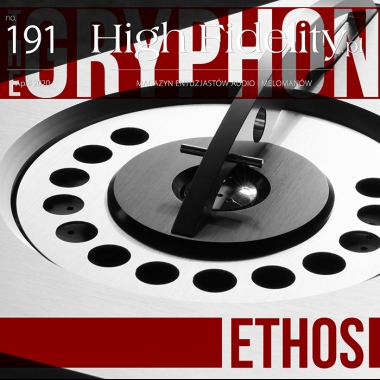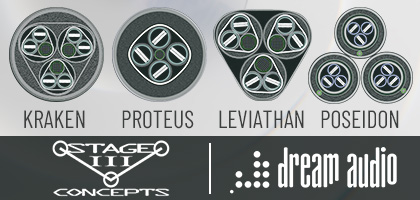No. 257 October 2025
- COVER REVIEW: ANCIENT AUDIO Silver Grand Mono Mk II ⸜ power amplifier • monoblocks » POLAND • Kraków
- KRAKOW SONIC SOCIETY № 153: 30 years of ANCIENT AUDIO » POLAND • Kraków
- FEATURE ⸜ music & technology: HISAO NATSUME presents - In search for the lost great pianism Chopin tradition » part 2 (France) » JAPAN • Tokyo
- REVIEW: AUDIOPHONIQUE Classic AP 300D ⸜ power amplifier » POLAND • Pruszków
- REVIEW: AVATAR AUDIO Holophony No. 1 ⸜ loudspeakers • floor-standing » POLAND • Osowicze
- REVIEW: DIVALDI Gold PA One ⸜ integrated amplifier » POLAND • Kraków
- REVIEW: J.SIKORA Aspire ⸜ turntable (deck + tonearm) » POLAND • Lublin
- REVIEW: MB AUDIO CABLE Silver ⸜ analog interconnect ⸜ RCA » POLAND • Turza Śląska
- REVIEW: XACT N1 ⸜ LAN switch » POLAND • Wrocław


|

|
|
FIRST PRESS COMPACT DISC

| Compact Disc It is different with Compact Disc releases. If I were a hardened fan vinyl - I am not deliberately not using the term „analogue”, because they are not synonyms - I would say that it is normal, because CD is a synonym of a cold sound, sound washed out of emotions. It would pretty nicely fit into a neat whole and I wouldn't have to think about it anymore. I could stay in my world - the world of details concerning, for example, the first LP pressings. However, I have the comfort of listening to all types of media, I know them quite well, I am not burdened with the emotional approach to LPs. And yet ... And yet I still and usually choose Compact Discs and Super Audio CDs as this "my" medium. If I had space for a high-quality reel-to-reel tape recorder - say Studer A-820 or Scully 280-2, silver discs would still be important to me, but number one would be copies of "master" tapes. However, since I don't have space, and the repertoire available on tapes is limited - I listen to music mainly from digital discs. 
Two of many titles prepared by Nimbus: Depeche Mode single and Enya’s debut And although they do not arouse as much emotions in music lovers as vinyl ones, also their world is internally rich, nuanced, simply interesting. You just need to know what to look for. The first step could be to look for editions of a given disc from different countries. It is exactly the same with CDs as with LPs - each country releases discs slightly differently. Which is not intuitively unambiguous - we subconsciously think that "a digit is a digit" and after the mastering stage all copies should be the same. They are not. | Master tape To understand why the CDs are not the same, it's worth taking a look at the path of the material that leaves the mastering studio. Historically, the "master" material was an analogue tape, followed by reel digital tapes - by Denon, Sounsdtream, Mitsubishi, 3M and - to the greatest extent - Sony . Since the late 1980s, DAT tape has become the mastering medium, followed by CD-R and CD-RW discs. For several years now, their role has been taken over by files that are sent to the pressing plant via the Internet. The best mastering studios, however, still provide material on physical media - that's what JVC does, using DVD-R or MO Disc, and Jacek Gawłowski is still preparing masters on gold CD-R discs (in DDP format though). Such a tape - or a disk - was then taken to a CD pressing plant, and its content was downloaded to the computer controlling the production of the "mother" glass matrix. A metal impression is then made of the glass matrix. And finally, liquid plastic (polycarbonate), is poured over the metal matrix surface. The whole is cured with UV radiation and sprayed with a thin layer of metal. This is how a CD is made. In this whole path, each element is a variable, which has a slightly different form in each country, every pressing plant. One of the critical issues is the process of preparing the glass matrix - the more accurate it is, the better. That is why the Japanese have been using ruby clocks for years in these systems, several orders of magnitude more accurate than standard ones. That's why JVC on XRCD and Sony on Blu-spec uses a slightly different pressing method - it uses so-called "Long pits" extended to the system’s tolerance limit. Among classic companies, throughout the 80s and early 90s, the best job in terms of preparing matrixes was done by the British company Nimbus. Look for the discs pressed by them - the inscription informing about it you will find at the cut out in the middle - it should say "Mastered by Nimbus". I have a lot of CDs of this type and even when I didn't know these dependencies, they always seemed different to me, better than "regular" discs. At least now I know why. 
The first Japanese release of Roger Water’s Amused to Death was released shortly after American one (22 days later); it is a „sample” version You should also listen to European and American versions of the same editions. It turns out that they are different, often even very much so. But there has also been a debate for years about which ones are better. In the case of LP, the matter is simple - the recordings made in European studies sounded better on European pressings (see - The Beatles) and vice versa (see - Miles Davis). Which was absolutely understandable. Simply because only copies of the "master" tape were sent across the pond, often even a copy of the backup, not the "master" itself. Each country also had its own way of preparing the vinyl release. |
It should be different with Compact Disc (and SACD). After all, it's always the first copy - from a digital master - and it should not matter where it goes. And yet it does. And that's because, not always, but that's the rule, the best CD pressings come from Japan, which attaches the greatest importance to this process. But I would not exclude pressings from the USA and Europe, especially when we start paying attention to which year the given edition comes from. | „First Press” CD If you have already read coverage of 125th meeting of the Krakow Sonic Society, you realize how important it is to acquire the earliest possible pressing of a LP. But even in this world it is not the norm. Please take a look at the excellent, even Benedictine work done by Matthew Lutthans, describing his adventures with Frank Sinatra records (HERE). Because, as it turns out, even the first pressing is not necessarily the right one or the best one. The case of Compact Discs is even more complex. With vinyls it is assumed that the original edition, i.e. the one that appeared on the day of the album's release, is the "first press" and that it is the most sought after (remembering all the exceptions and subtleties associated - for example - with the place of pressing). It is assumed that this is the original release. The introduction of Compact Disc changed everything. From that moment, the silver disc was often on the market earlier than LP, it often contained bonus recordings that were not included on LP - and all this to promote the new format. It could therefore be assumed that the CD editions are at least parallel to the LP editions, and sometimes overtake them. However, while LP releases to - let's say - the mid-1980s sounded best from the first pressing, the Compact Disc introduces a different perspective to the "first press" issue. Most of them, at least until the 2000s, were made of analog rather than digital tapes. So they were digital copies. And it was possible to make a lot of such copies, either in parallel, for various mastering studies, or in subsequent years. What's more, the same copy could be released in different countries, which was used by Japan - it was there that the best versions of CDs were released. But it was also possible to release the disc in a non-standard way - for example, on a gold disc. Such a version, even if created from exactly the same "master" as the aluminum version, usually sounded better. 
Benjamin Britten and Young Person's Guide to the Orchestra on XRCD24 disc from 2003; it’s a „sample” version In the mid-1980s, JVC introduced K2 encoding and XRCD discs. Their releases are usually much better than the first CD pressings. In recent years, Blu-spec, HQCD and SHM-CD versions have followed a similar path with their "tuned up" versions called BSCD2, Ultimate and Platinum. They also, in principle, sound better than the first pressings, though - let me say - this is not the rule. The reason for the improvement in sound quality are increasingly better analog-to-digital converters and a better understanding of the specificity of "digital processing" by mastering engineers. The advantage of the first CD pressings from the 80s and the first half of the 90s (later the advantage is not so clear anymore) was the low compression used on them. When you compare the frequency measurement of "first press" and any remaster from the 90s and parts of the 2000s, you will see that the "peaks" of the signal are cut off on the latter. The whole sounds louder, it's true, but it is also not very dynamic and flat in terms of colors. It is often digitally distorted. This is the time referred to in the professional press as "loudness war," or war over whose record will play louder on the radio and in the car. Therefore, a large part of the remasters from that period is flawed and hard to listen to. | What to look for? That is why the first CD pressing is usually the most expensive one. When you look at ebay auctions, you'll see that you have to pay a lot of money for the first issues. When it comes to Japanese releases, for example, you should look for those that have the so-called "Black triangle". For releases of Depeche Mode discs the best are those released by Warner-Pioneer Corporation. But there is also a trap - they were released twice and later one does not have this inscription on the cover anymore, although it features the same catalog number. There are plenty of such nuances - you need to look for people who collect albums by a specific artist, it is worth using in your search the tips of the discogs.com, but use them only as clues not decisive arguments. The prices of these editions are high, especially if the number of released units was low. The album with two songs of Wish You Were Here by Pink Floyd, released in Japan, the so-called "GOLD FACE" will cost you as much as 2700 USD on the auction. However, if I had to specify a path that should be followed, I would start searching by checking if the title was released on the XRCD. The most expensive ones cost $ 200 or more, and the River of Sorrow of First Impression Music (Limited No. 2220/5000) is offered for $399. Jacintha on XRCD always sells above $150, as do Three Blind Mice discs. But they are worth it. 
Another interesting case – two releases of Abraxas 99. Original (on the right) was released in 1999. The 2011 re-issue was prepared from exactly the same master, but on gold disc. And yet the former still sound better… The second step would be checking the „1st press”. These editions are not very resolving or selective, but they have a well-preserved character of the analog original. The next step would be a version on a golden disc, and then on one of the new "patents": Blu-spec, HQCD, SHM-CD (and their newer versions). Gold discs, like DCC’s, can cost $200 or more, but it's worth it. In turn, the foiled versions of Classic Records and the most sought after Mobile Fidelity titles will set you back a $1000 or more. And, additionally, in each of these case you should look for copies marked „sample” – you can be sure they come from the first ever pressed batch, which is made from „fresh” or not worn off matrixes. Because it's worth looking for the best CD releases that are available. The sound of a good release and an average one differs enormously - no less than the LP pressings differ from each other. And I don't know if you’ve noticed, but when writing about CDs, every now and then I referred to a category that also applied to vinyl records. Because, in fact, these are very similar types of "hunts" and getting the "best" CD (or SACD) release brings as much emotion and joy as the dreamed, the first pressing of the first version of a vinyl record. WP |
About Us |
We cooperate |
Patrons |
|
Our reviewers regularly contribute to “Enjoy the Music.com”, “Positive-Feedback.com”, “HiFiStatement.net” and “Hi-Fi Choice & Home Cinema. Edycja Polska” . "High Fidelity" is a monthly magazine dedicated to high quality sound. It has been published since May 1st, 2004. Up until October 2008, the magazine was called "High Fidelity OnLine", but since November 2008 it has been registered under the new title. "High Fidelity" is an online magazine, i.e. it is only published on the web. For the last few years it has been published both in Polish and in English. Thanks to our English section, the magazine has now a worldwide reach - statistics show that we have readers from almost every country in the world. Once a year, we prepare a printed edition of one of reviews published online. This unique, limited collector's edition is given to the visitors of the Audio Show in Warsaw, Poland, held in November of each year. For years, "High Fidelity" has been cooperating with other audio magazines, including “Enjoy the Music.com” and “Positive-Feedback.com” in the U.S. and “HiFiStatement.net” in Germany. Our reviews have also been published by “6moons.com”. You can contact any of our contributors by clicking his email address on our CONTACT page. |
 



|
   |
main page | archive | contact | kts
© 2009 HighFidelity, design by PikselStudio,
projektowanie stron www: Indecity







 inyl records arouse emotions - it's probably clear. Just read the entries on the forums dedicated to new releases, or find threads where the first issues are mentioned, to see a similar passion, feel the high temperature of these discussions. Not only vinyl records are subjects of such heated debates. Even greater tensions are caused by fragments, small parts, often details - and they seem to ignite the participants of these conversations the most.
inyl records arouse emotions - it's probably clear. Just read the entries on the forums dedicated to new releases, or find threads where the first issues are mentioned, to see a similar passion, feel the high temperature of these discussions. Not only vinyl records are subjects of such heated debates. Even greater tensions are caused by fragments, small parts, often details - and they seem to ignite the participants of these conversations the most.


